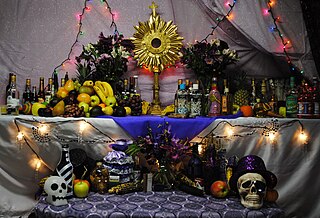Related Research Articles

The loa are the spirits of Haitian Vodou and Louisiana Voodoo. They are intermediaries between Bondye – the Supreme Creator, who is distant from the world – and humanity. Unlike saints or angels, however, they are not simply prayed to, they are served. They are each distinct beings with their own personal likes and dislikes, distinct sacred rhythms, songs, dances, ritual symbols, and special modes of service. Contrary to popular belief, the loa are not deities in and of themselves; they are intermediaries for, and dependent on, a distant Bondye or god.

Damballa, also spelled Damballah, Dambala, Dambalah, among other variations, is one of the most important of all loa, spirits in Haitian Vodou and Louisiana Voodoo traditions. He is portrayed as a great white serpent, originating in the city of Wedo in modern-day Benin. Damballa is said to be the Sky Father and the primordial creator of all life, or the first thing created by Gran Met. In those Vodou societies that view Damballa as the primordial creator, he created the cosmos by using his 7,000 coils to form the stars and the planets in the heavens and to shape the hills and valleys on earth. In others, being the first thing created by God, creation was undertaken through him. By shedding the serpent skin, Damballa created all the waters on the earth. As a serpent, he moves between land and water, generating life, and through the earth, uniting the land with the waters below. Damballa is usually syncretized with either Saint Patrick or Moses. He is counted among the Rada loa.

Maman Brigitte also written as Manman Brigitte and also known by Gran Brigitte, Grann Brigitte, Manman, Manman Brigit, and Maman Brijit is a death loa and the consort of Baron Samedi in Haitian Vodou. She drinks rum infused with hot peppers and is symbolized by a black rooster. Like Samedi and the Guede, she is foul-mouthed. She is also the adoptive mother of Guede Nibo.

Erzulie is a family of loa, or spirits, in Vodou.
Gran Maître is the primary creator god in Haitian Vodou. He is the equivalent of the Judeo-Christian God.
Kalfu is one of the petro aspects of Papa Legba, a loa in Haitian Vodou. He is often envisioned as a young man or as a demon; his color is red and he favors rum infused with gunpowder. He is often syncretized with Satan.
The music of Martinique has a heritage which is intertwined with that of its sister island, Guadeloupe. Despite their small size, the islands have created a large popular music industry, which gained in international renown after the success of zouk music in the later 20th century. Zouk's popularity was particularly intense in France, where the genre became an important symbol of identity for Martinique and Guadeloupe. Zouk's origins are in the folk music of Martinique and Guadeloupe, especially Martinican chouval bwa, and Guadeloupan gwo ka. There's also notable influence of the pan-Caribbean calypso tradition and Haitian kompa.
Dutty Boukman was an early leader of the Haitian Revolution. Born in Senegambia, he was captured, enslaved and transported to Jamaica. He eventually ended up in Haiti, where he became a leader of the Maroons and a vodou houngan (priest).

A veve is a religious symbol commonly used in different branches of Vodun throughout the African diaspora, such as Haitian Vodou. Veves should not be confused with the patipembas used in Palo, nor the pontos riscados used in Umbanda and Quimbanda since these are separate African religions. The veve acts as a "beacon" for the Loa, and will serve as a loa's representation during rituals.

Houngan or oungan is the term for a male priest in Haitian Vodou. The term is derived from the Fon word hounnongan. Houngans are also known as makandals.
Bois Caïman was the site of the first major meeting of enslaved Blacks during which the first major slave insurrection of the Haitian Revolution was planned.

Carrefour is a largely residential commune in the Port-au-Prince Arrondissement, in the Ouest department of Haiti. The commune had a population of 373,916 at the 2003 census, and was officially estimated to have grown to 511,345 inhabitants in 2015. It is mostly a bedroom community for those who work in central Port-au-Prince.

Homosexuality in Haitian Vodou is religiously acceptable and homosexuals are allowed to participate in all religious activities. However, in countries with large Vodou populations, some Christian influence may have given homosexuality a social stigma, at least on some levels of society.
A bokor (male) or caplata (female) is a Vodou witch for hire who is said to serve the loa "with both hands", practicing for both good and evil. Their black magic includes the creation of zombies and the creation of 'ouangas', talismans that house spirits.
Carrefour is a French word meaning road intersection.
Vodou drumming and associated ceremonies are folk ritual faith system of henotheistic religion of Haitian Vodou originated and inextricable part of Haitian culture.

Cornillon is a commune in the Croix-des-Bouquets Arrondissement, in the Ouest department of Haiti. It has 54,254 inhabitants.
Grand Bois may refer to:

The communal section is the smallest administrative division in Haiti. The 144 communes are further divided into 571 communal sections.
